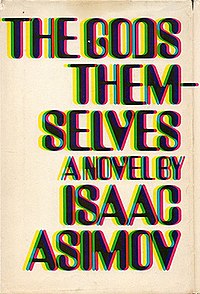The Gods Themselves

Cover of first edition (hardcover)
|
|
| Author | Isaac Asimov |
|---|---|
| Cover artist | David November |
| Country | United States |
| Language | English |
| Genre | Science fiction |
| Publisher | Doubleday |
|
Publication date
|
1972 |
| Media type | Print (hardback & paperback) |
| Pages | 288 |
| Awards | Locus Award for Best Novel (1973) |
| ISBN | |
The Gods Themselves is a 1972 science fiction novel written by Isaac Asimov. It won the Nebula Award for Best Novel in 1972, and the Hugo Award for Best Novel in 1973.
The book is divided into three main parts, originally published in Galaxy Magazine and Worlds of If as three consecutive stories. The book opens at chapter 6, segments of which appear between chapters as the narrative proceeds through chapters 1 to 5. In effect, chapters 1 to 5 are flashbacks in the narrative of chapter 6, giving the history leading up to the present time of chapter 6. Chapter 6 then concludes, and the story proceeds with chapter 7.
The main plot-line is a project by aliens who inhabit a parallel universe (the para-Universe) with different physical laws from this one. By exchanging matter with Earth, they seek to exploit these differences in physical laws. The exchange of matter provides an alternative source of energy in their dying Universe. However, the exchange of physical laws will have the ultimate result of turning the Earth's Sun into a supernova, and possibly even turning a large part of the Milky Way into a quasar. This is the alien's ultimate goal, as it would provide more energy for the para-Universe.
The exact time when the novel occurs isn't specified, but it is stated to be approximately two and a half centuries since the Opening of Japan and a century and a half since the discovery of quasars, suggesting early 22nd Century.
The first part takes place on Earth, almost a century after the "Great Crisis", where ecological and economic collapse reduced the world's population from six billion to two billion. Radiochemist Frederick Hallam discovers that a container's contents have been altered. He initially accuses a colleague of tampering with his sample, but eventually finds that the sample, originally tungsten, has been transformed into plutonium 186—an isotope that cannot occur naturally in our universe. As this is investigated, Hallam gets the credit for suggesting that the matter has been exchanged by beings in a parallel universe; this leads to the development of a cheap, clean, and apparently endless source of energy: the "Electron Pump", which transfers matter between our universe (where plutonium 186 decays into tungsten 186) and a parallel one governed by different physical laws (where tungsten 186 turns into plutonium 186), yielding a nuclear reaction in the process. The development process grants Hallam high position in public opinion; winning him power, position, and a Nobel Prize. Despite his success Hallam is a mediocre scientist who is inclined to take punitive action against anyone who threatens his legacy.
...
Wikipedia
